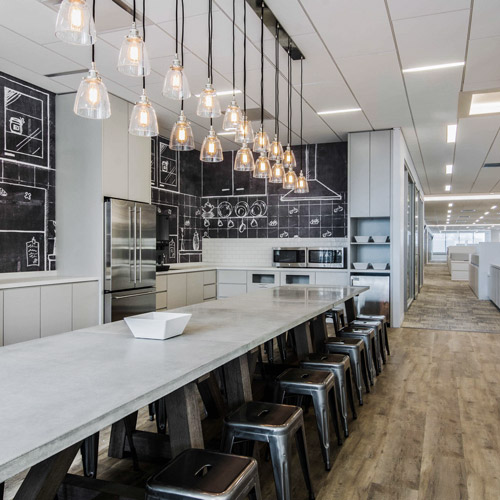The success of Chicago-based architecture firm Pappageorge Haymes Partners during its more than 35 years of history stems from the unique chemistry between cofounders David A. Haymes, AIA, and George Pappageorge, FAIA. Still, the two are quick to share credit with the firm’s senior associate partners for its accomplishments and aesthetic cohesion over the years.
“We have a very tightly knit group of people with whom we have incredible relationships,” says Haymes, who launched the firm with Pappageorge in 1981. “The least tenured of the five individuals who form our senior associate partner group is 22 years.”
Haymes adds that the firm’s signature collaborative leadership model has grown to include six associates, five of whom have been on staff for more than 10 years. Both Haymes and Pappageorge take great pride in the longevity of this highly committed “collective,” and its role in the firm’s successful evolution and extensive design portfolio.
“We’ve been together for a long time and have a great deal of experience and work well together,” Haymes says. “As a result, we manage to get a lot of great things done.”
Pappageorge Haymes Parners takes on a wide variety of projects in terms of size and scale, ranging from small urban infill projects to large horizontal developments and towers. A good example of a project of grand size is the 465 North Park building, situated between Navy Pier and the Tribune Tower in downtown Chicago.

“Architecturally, it’s really a material deviation from the norm in the Streeterville area,” Haymes says, adding that the character of the neighborhood is more angular and heavy.
The floor plan of 465 North Park is derived from two angled ellipses that slide apart, resulting in an expressive form and an unconventional floor plan that offers select view corridors, including extensive views of Lake Michigan. A third ellipse positioned above the podium houses common spaces, including the lobby and a workout facility.
“We originally envisioned the floor plan as resembling the randomness of fallen leaves,” Haymes says. “The building is very three-dimensional in terms of its shape, while appearing light and airy in its context.”
The evolving scope of the firm’s portfolio is evidenced by The 65th Infantry Borinqueneers Veteran’s Apartments, which celebrated its grand opening in August 2016. Imbedded in an established residential district anchored by a major hospital, the building is a multidimensional, permanent-housing facility geared to the special needs of at-risk veterans and their families.
The building’s L-shaped plan reduces its bulk and helps it blend into the district. Optimum accessibility, day-lit corridors throughout, and cheerful common areas enhance the interior spaces and spirit of the residence.
Making History Modern
The firm deftly handled a number of renovation projects as well, including its recent work at the Arc at Old Colony. Built in 1894, and added to the National Register of Historic Places in 1976, the structure—known as the Old Colony Building—was the first of its kind to use a portal-braced skeletal frame to help it withstand strong lake gusts. It also allowed for oversized double-hung windows, high ceilings, and air spaces in a narrow footprint.
Originally created as a high-end office space, the building had fallen into significant disrepair by the time Campus/MCJ Development hired Pappageorge Haymes Partners to help transform it into student-oriented apartments. The redevelopment and modernization of the historically intact structure took advantage of the many surviving original (and historic) components, including the complex reconstruction of the original arched Van Buren Street entry. The building’s namesake portal arches were also preserved in units throughout.
“The reason it’s called ‘The Arc’ is its steel frame,” Haymes says. “The taller you go with a building, the more horizontal load you have to design for. The way this was accomplished was by the use of arches that connected certain bays within the building. We exposed these arches to make them an architectural feature in the interior.”

The arches weren’t the only original design cue Pappageorge Haymes Partners preserved and featured in the renovation. Marble-clad walls, interior glazed office partitions, ornate trim, mosaic floors, and precast “scagliola” plaster also survive in the otherwise minimalist and modern interior design that proved so appealing to resident millennials.
Arc at Old Colony opened for occupancy in August 2015, and within six months attained 83 percent occupancy—significantly exceeding projections and the absorption rate of similar buildings in the area. The building’s current occupancy of more than 95 percent—and the ongoing positive economic impact visible throughout the area—are clear indicators of its success. Given that the project already won multiple awards, including a Preservation Excellence Award from the Commission on Chicago Landmarks and a Merit Award from the Chicago Building Congress, it proved to be money well spent.
Creating Homes Away from Home
As Pappageorge Haymes Partners has grown, so has its reach beyond Chicago. One such project is the highly visible River Oaks District in Houston, Texas, on which the firm teamed with design architect Gensler. Nestled in the city’s high-end Uptown-Galleria neighborhood, the new 15-acre, mixed-use development is a unique enclave of boutique retail, restaurants, office space, and upscale apartments, specially tailored to expand the appeal of the popular destination point.
One of the firm’s signature away-from-home projects, however, is in Hawaii. Haymes says Pappageorge Haymes Partners was referred to a local architecture firm in Honolulu to help with a new residential project. This partnership resulted in the highly successful residential tower, Waihonua at Kewalo.
“As a result of how successfully that project went, the client looked to us to be the primary architect on a second project named ‘The Collection,’” Haymes says.
The Collection is an innovative, mixed-use complex that includes tower, midrise, townhouse, and commercial components configured as a pedestrian-friendly district with premium lifestyle amenities and easy access to commercial venues.
“All of these buildings wrap around a parking structure that serves all of them,” Haymes says. “There are also retail and restaurant components.”
As of press time, The Collection’s 397-unit tower was scheduled to reach completion by the end of 2016, followed by completion of the other buildings sometime in 2017. Haymes adds that all of the condominium units have already been sold, and the community has embraced the project, thanks to a design that fits in with the rest of the neighborhood.
In the end, what’s kept clients coming back to Pappageorge Haymes Partners for the past 35 years is the firm’s easy approachability and its functional, context-oriented design approach.
“It’s been a team effort,” Haymes says.


